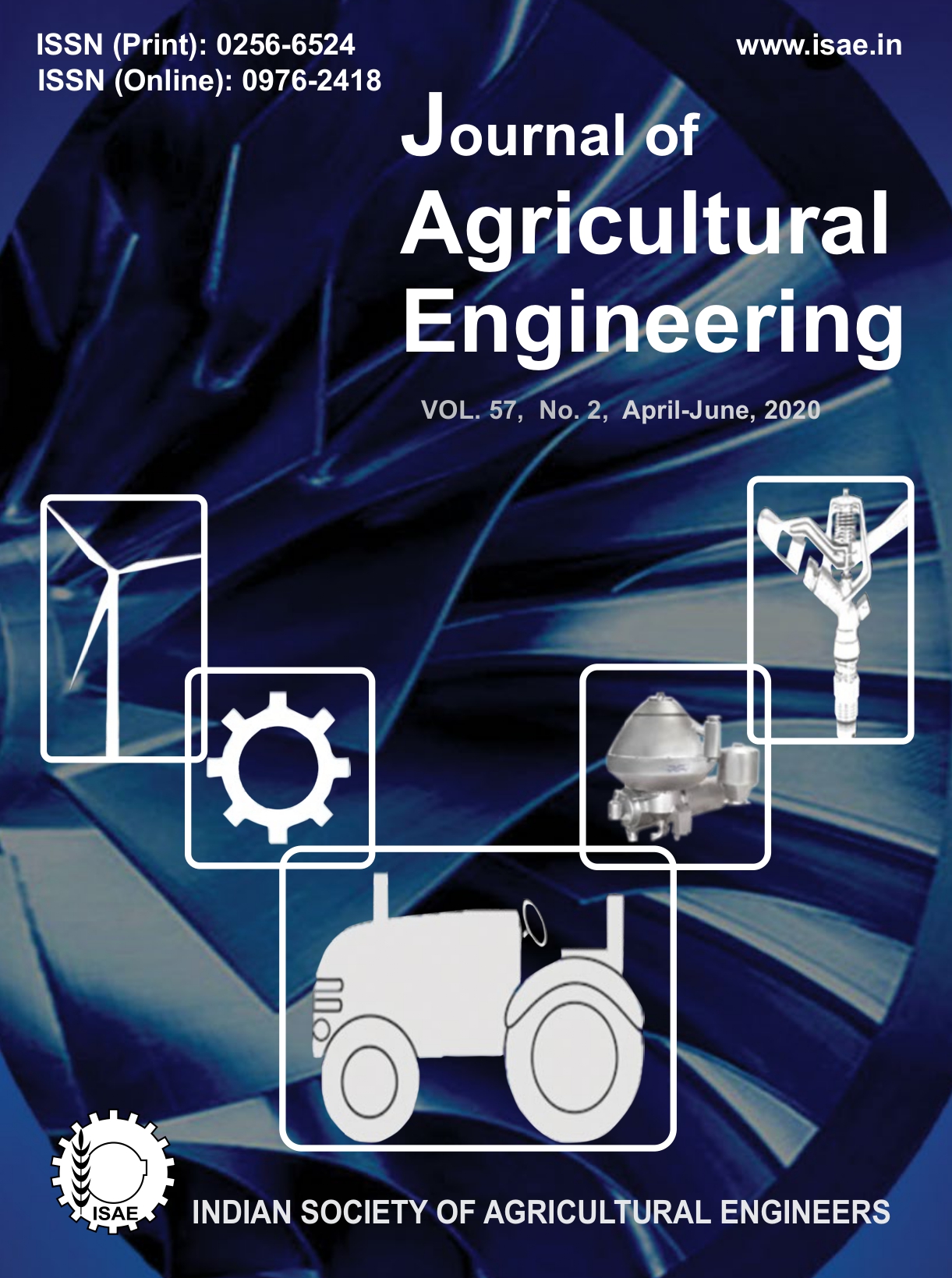Artificial Neural Network Models for Estimation of Potential Evapotranspiration in a Semi-arid Region of Raichur, Karnataka
DOI:
https://doi.org/10.52151/jae2020572.1713Keywords:
Evapotranspiration, potential evapotranspiration, artificial neural network, feed forward neural network, Bayesian regularizationAbstract
Accurate estimates of evapotranspiration by employing efficient and proven softcomputing techniques that involve least number of influencing variables are important to tackle present water crisis. In the present study, Artificial Neural Network (ANN) models were developed to predict the potential evapotranspiration (PET) in Raichur, Karnataka, using six input parameters viz., maximum and minimum temperatures, maximum and minimum relative humidity, sunshine hours and wind speed. The models were trained with Bayesian Regularization (BR) and Gradient Descent training algorithms with Momentum and Adaptive Learning Rate Back Propagation (GDX). The results revealed correlation coefficient of 0.99 between actual and predicted PET for ANN-BR model with 0.1448 mm root mean square error for validation period, which indicated a better performance over the ANN-GDX model. Therefore, ANN-BR model was chosen for predicting PET in the study area.
References
Abdalkareem G; Yousef B H; Ali A S. 2017. Estimation of reference evapotranspiration based on only temperature data using artificial neural network. Am. J. Innovative Res. Appl. Sci., 4(5), 157-162.
Adamala S; Srivastava A. 2018. Comparative evaluation of daily evapotranspiration using artificial neural network and variable infiltration capacity models. Agric. Eng. Int.: CIGR J., 20(1), 32-39.
Allen R G; Pereira L S; Raes D; Smith M. 1998. Crop evapotranspiration: Guidelines for computing crop water requirements. FAO Irrigation and Drainage Paper 56, United Nations FAO, Rome, Italy, pp: 300.
Anandakumar; Maheshwara Babu B; Satish Kumar U; Srinivasa Reddy G V. 2016. Groundwater level forecasting using artificial neural network for Devasugur Nala watershed in Raichur district, Karnataka J. Agric. Eng., 53 (3), 19-27.
ASCE Task Committee on application of artificial neural networks in hydrology. 2000a. Artificial neural networks in hydrology-I: preliminary concepts. J. Hydrol. Eng., 5(2), 115-123.
ASCE Task Committee on application of artificial neural networks in hydrology. 2000b. Artificial neural networks in hydrology-II: hydrologic applications. J. Hydrol. Eng., 5(2), 124-137.
Azhar A H; Masood M; Nabi G. 2013.Performance evaluation of reference evapotranspiration equations under semiarid Pakistani conditions. Arab J. Sci. Eng., 3, 1-12.
Chowdhury A; Gupta D; Das D P; Bhowmick A. 2017. Comparison of different evapotranspiration estimation techniques for Mohanpur, Nadia district, West Bengal. Int. J. Comput. Eng. Res., 7(4), 33-39.
Citakoglu H; Cobaner M; Haktanir T. 2014. Estimation of monthly mean reference evapotranspiration in Turkey. Water Resour. Mgmt., 28, 99-113.
Daliakopoulos I N; Coulibaly P; Tsanis I K. 2005. Groundwater level forecasting using artificial neural network. J. Hydrol., 309, 229-240.
Haykin S. 1999. Neural Networks, a Comprehensive Foundation. Prentice Hall Publishers, Englewood Cliffs, N.J., 115-122.
Islam A; Ahuja L R; Garcia L A; Ma L; Saseesndran A S. 2012. Modeling the effect of elevated CO2 and climate change on potential evapotranspiration in the semi-arid central Great Plains. Trans. ASABE, 55(6), 2135-2146.
Kale M U; Nagdev M B; Bagade S D. 2013. Estimation of evapotranspiration with ANN technique. J. Indian Water Res. Soc., 33(1), 23-29.
Kambale J B; Singh D K; Sarangi A. 2017. Modelling climate change impact on crop evapotranspiration. Nature Environ. Pollut. Technol., 16(3), 953-958.
Kayri M. 2016. Predictive abilities of Bayesian regularization and Levenberg–Marquardt algorithms in artificial neural networks: A comparative empirical study on social data. Math. Comput. Appl., 21(2), 1-11.
Kelley J; Pardyjak E R. 2019. Using neural networks to estimate site-specific crop evapotranspiration with low-cost sensors. Agron. J., 9(2), 29-34.
Meshram R V; Deshmukh M M; Wadatkar S B; Kale M U; Mankar A N. 2015. Prediction of reference evapotranspiration using artificial neural network. Int. J. Agric. Eng., 8(1), 1-8.
MathWorks. 2012.Artificial Neural Network Tool Box. User’s Guide (R2012a), The Math Works Inc., Natick, Massachusetts, USA. https://in.mathworks. com/help/matlab/index.html (Retrieved July 14,2012)
Mhetre P B; Kamble P S; Jadhav J D. 2013. Estimation of PET measurement and actual AET in groundnut by various methods. Asian J. Environ. Sci., 8(2), 130-135.
Nayak P C; Satyaji Rao Y R; Sudheer K P. 2006. Groundwater level forecasting in a shallow aquifer using artificial neural network approach. Water Res. Manage., 20(1), 77-90.
Nema M K; Khare D; Chandnih S K. 2017. Application of artificial intelligence to estimate the reference evapotranspiration in sub-humid Doonv alley. Appl. Water Sci., 7, 3903-3920.
Nourani V; Kisi O; Komasi M. 2011. Two hybrid artificial intelligence approaches for modeling rainfall– runoff process. J. Hydrol., 402(1), 41-59.
Pakhale G K; Nale J P; Temesgen W B; Muluneh W D. 2015. Modelling reference evapotranspiration using artificial neural network: A case study of Ameleke watershed, Ethiopia. Int. J. Sci. Res. Pub., 5(4), 1-8.
Pandey S; Kumar M; Chakraborty S; Mahanti N C. 2014. A statistical comparison of reference evapotranspiration methods: A case study from Jharkhand state of India. Int. J. Innovative Res. Sci. Eng. Technol., 3(1), 8765-8777.
Patil R; Nagaraj D Z M; Gouda Shrikanta; Rathod S; Polisgowdar B S. 2020. Accuracy testing of box Jenkins models in forecasting potential evapotranspiration for Raichur district. J. Pharmacogn. Phytochem., 9(2), 826-830.
Rajurkar M P; Kothyari U C; Chaube U C. 2002. Artificial neural networks for daily rainfall–runoff modelling. Hydrol. Sci., 47(6), 865-877.
Sekhar K C R; Jyothy S A; Mallikarjuna P. 2012. Evaluation of evapotranspiration estimation methods and development of crop coefficients for groundnut crop. J. Eng., 2(6), 35-42.
Sudheer K P; Nayak P C; Ramasastri K S. 2002. Improving peak flow networks: A neural network modeling approach for hydrological processes. Water Resour. Res., 42, 1-14.
Tamta S; Kashyap P S; Kumar P. 2018. Estimation of evaporation in hilly area by using Ann and Canfis system based models. Int. J. Curr. Microbiol. App. Sci., 7(1), 911-919.
Umamaheswari G R; Kalamani D. 2014. Adaptive neuro fuzzy inference system for monthly groundwater level prediction in Amaravathi river minor basin. J. Theo. Appl. Info. Technol., 68(3), 523-530.














